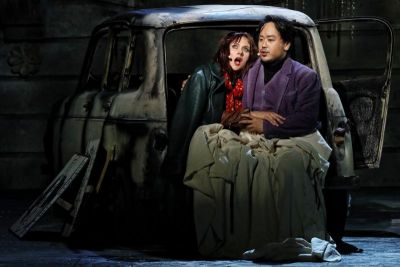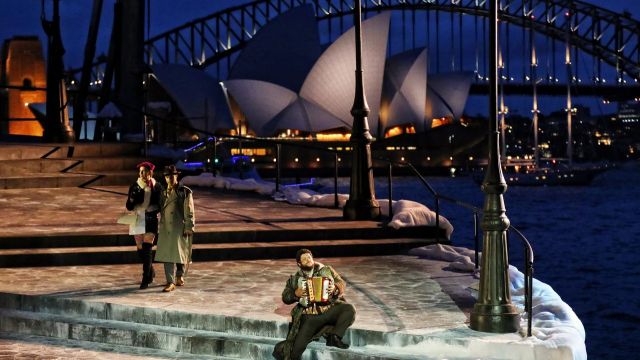La Bohème
Rain clouds that have hovered threateningly over the city all day begin to clear. Late afternoon sunshine begins to filter through. The harbour begins to sparkle. What has been a dull and dreary day turns into a balmy, Sydney, autumn evening. How lucky for the opening night of another Handa Opera on the Harbour!
As the sky darkens above the Bridge and the Opera House, a crescent moon shines through the last wisps of cloud – and the lights go up on a snow-encrusted stage. It is a wintery December night in Paris. La Bohèmeis about to begin.
The wide, floating stage is a chilly street of the Latin Quarter, complete with towering Paris street lamps. Above the stage is an attic garret, the artlier of four struggling artists trying to make a living. A skylight suspended above it is a huge screen framed by icy stalactites. Here, projections of Paris landmarks under falling snow encapsulate the scene.
It is not, however, the Paris that Puccini envisaged in 1896. This is Paris in 1968, besieged by the “May revolution” where student demonstrations, riots and a general strike almost brought the country to a standstill, but also brought about a wealth of protest art and music.
It is, it would seem, a fitting re-imagining of an opera about struggling, fun-loving artists in freezing garrets, new-found love, bitter jealousy and a crippling illness!
 La Bohème– is the age-old “boy meets girl” tale of love found, lost and found again, often, as in this case, unfortunately too late.
La Bohème– is the age-old “boy meets girl” tale of love found, lost and found again, often, as in this case, unfortunately too late.
The struggling artists are Marcello (painter), Rudolfo (writer), Colline (philosopher) and Schaunard (musician). When Schaunard arrives home with money received for playing his violin to a parrot until it died, they decide to go through the busy ‘Quartier Latin’
to the ‘Café Momus’to celebrate.
Rudolfo stays behind and meets Mimi, who has come knocking on the door for a match to light her candle. They fall in love and join the others, where Marcello re-ignites his love for the lovely Musetta.
Passion, jealousy and the need for money constantly divide and re-unite the lovers until, at last, they are together again, remembering their past happiness … as Mimi, alas, dies from consumption.
Take this story to 1968 and designers Dan Potra (set) and Marco Devetak (video) come into their own. ‘Café Momus’ becomes a night club in the thriving, busy twentieth century ‘Quartier Latin’, complete with street entertainers, stilt-walkers and torch throwers. The toy seller, Parpignoi, appears suspended from a crane in a basket decorated with multi-coloured balloons, and spirits one of the children away in a swing that hangs below. Musetta arrives in a ’60s police car that drives along the harbour broad walk. And snow falls from light stands high above and the screen behind the seating stands where maestro Brian Castles-Onion, from a hidden orchestra pit, conducts the singers via video.
At interval, cranes bring two battered car frames high over the water and carefully lower them onto the stage. There they are secured over smoke machines for the second act, where one burns as street cleaners clear the result of demonstrations, and headlines on the riots from Parisian and world newspapers report scroll up the massive screen above.

If it appears I am concentrating on the spectacle rather than the music and singing, forgive me – but that’s what these annual operas are about. They are unique ‘events’ that, in the words of the NSW Premier, “attract visitors from across the world”. They require months of planning, preparation and construction, complex mechanization, and extraordinarily sophisticated sound and lighting. The work behind them is remarkable. For instance …
It took 150 people to construct the stage that can support 150 tonnes. It took 32 people nearly 6000 hours to build the scenery. A complicated system of leads and lamps support the 223 speakers that carry the music and voices and the 230 moving lights that illuminate the stage.
The wardrobe department spent over 7000 hours making the costumes. There are 560 props, and 114 pairs of shoes. And surf lifesavers patrol the area right through and every performance to ensure the safety of the cast, the crew … and the audience.
It’s some ‘event’!
If the opera itself seems to fade into insignificance, be assured, it doesn’t. The acoustics are getting better every year. The music is Puccini and the 50 plus Opera orchestra at its vibrant best, despite the fact that they are hidden beneath the stage in a custom-built studio known as ‘The Underworld’. The rich voices of the performers ring our clearly and purely through the multi-faceted sound system – though some find the distance and the necessary use of microphones make it difficult at times to work out exactly who is singing, especially in quartets and crowd scenes.
Romanian soprano Iulia Maria Dan is a frail, yet beautifully resonating Mimi, her notes reaching high into the autumn sky in “Sì, mi chiamano Mimì” (Yes, they call me Mimì).
 Celebrated Seoul-born tenor Ho-Yoon Chung finds the wonderful range necessary for Rudolfo – and their first duet “O lovely girl” is joyfully exultant.
Celebrated Seoul-born tenor Ho-Yoon Chung finds the wonderful range necessary for Rudolfo – and their first duet “O lovely girl” is joyfully exultant.
Powerful baritone Samuel Dundas, as an energetic and caring Marcello, adds to his vast Australian and New Zealand musical repertoire and Julie Lea Goodwin is a bewitching, provoking Musetta, especially in her solo “Quando m'en vo”(When I go along).
All four voices come stunningly together in the quartet, “Addio dolce svegliare alla mattina!”(Goodbye, sweet awakening in the morning!), at the end of the Third Act.
Richard Anderson plays the philosophical Colline, and Christopher the musical Schaunard. John Bolton-Wood plays Benoit and Alcindo, Douglas McRae an Officer and James Old the sergeant. It is Simon Gilkes who swings under the balloons as the colourful Parpignol.
Supported by a cast of 38 chorus members, six actors and an enormous back stage and mechanical crew, they take Puccini’s La Bohèmefrom 1896 into the 20th century in a 21st century production that shows just what “multi-disciplined theatre” means.
Carol Wimmer
Photographer: Prudence Upton
Subscribe to our E-Newsletter, buy our latest print edition or find a Performing Arts book at Book Nook.

